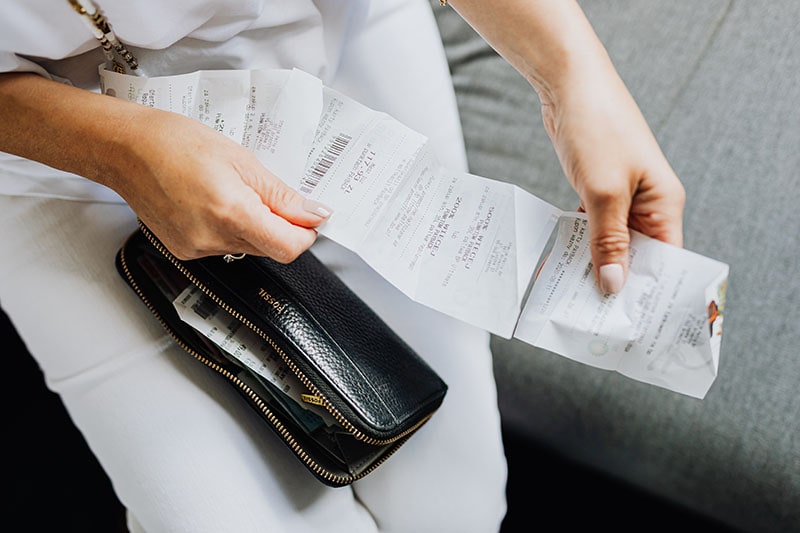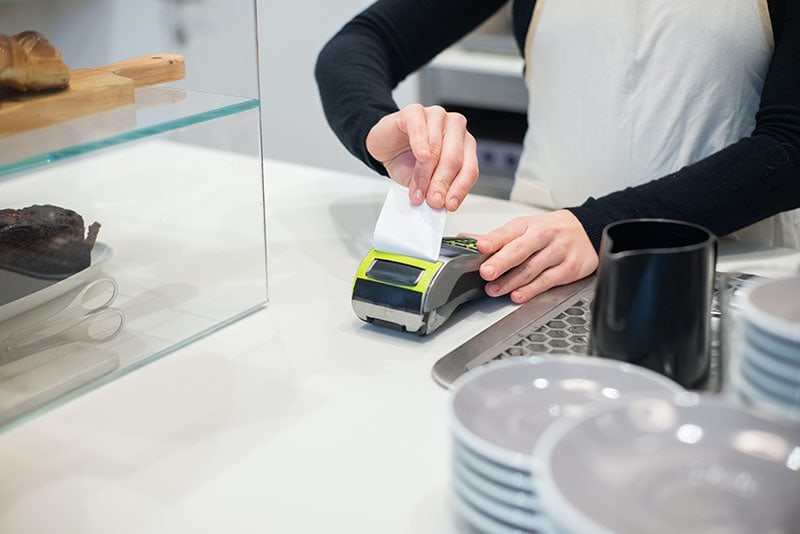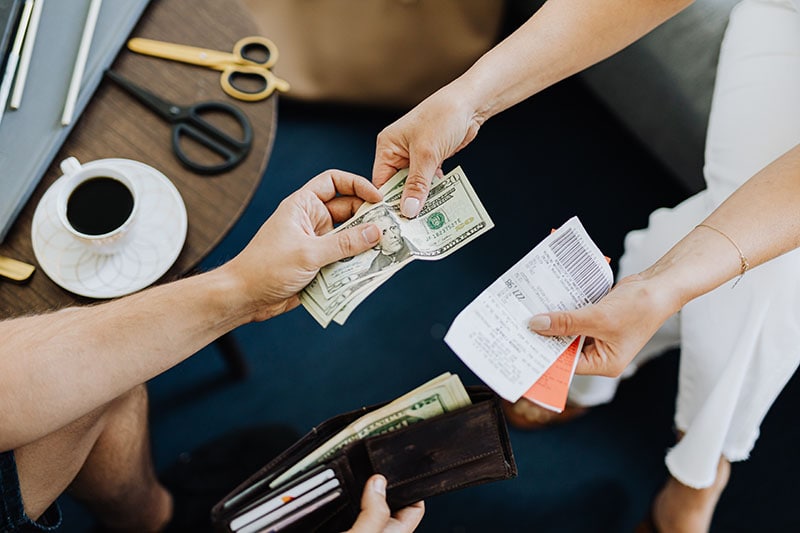Are Receipts Recyclable? How Do You Properly Dispose of Them?
-
Pete Ortiz
- Last updated:

In almost any purchase you make, you’ll receive a receipt. You may have many of them from the purchases you make, accumulating in your bags and drawers. Have you ever asked yourself if you can recycle all those receipts? The truth is that most of the receipts are not recyclable. The only receipts you can recycle are those made of 100% paper.
These days, most receipts are made of thermal paper, which is not recyclable because it contains a chemical called bisphenol-A (BPA), which is applied to the printing surface during the production of thermal paper. BPA is a highly stable compound that does not degrade easily in the environment.
As a result, when recycled paper is made into new products, it can still contain BPA. Since we want to become environmentally friendly, we can do several things to combat this.
We’ll look at how you can dispose of receipts well and why the thermal paper is used when producing receipts. Besides, we’ll give you tips on how you can avoid receiving receipts at various outlets. Keep reading to learn more!
How Do You Dispose of Receipts Properly?
Before you dispose of them, use a receipt holder or folder to keep them organized in one place. This way, they don’t get lost or crumpled up in a drawer. You can use folders with pockets specifically designed for holding receipts. You can also create your own by cutting out sections from file folders.
Once the receipts have accumulated, it’s time to dispose of them. As we mentioned earlier, you cannot recycle receipts made from thermal paper. The chemical contained (Bisphenol-A) cannot be removed during recycling.
The only safe way to dispose of these receipts is to throw them in the trash. Collect all the receipts you have, and put them in a plastic bag, seal it well and put it in the trash can. Then, scrub your hands using soap and water. That’s the only effective method of keeping bisphenol-A away from the surroundings. Throwing the receipts in the trash will also ensure they don’t get recycled.

How to Identify if a Receipt has BPA
Scratch the printed side of the receipt with your fingernail, coin, or another sharp object. If it turns black, then you know that it contains BPA. It means chemicals are leaching from the paper into your skin when you touch it. These chemicals can cause irritation and infection if left untreated.
You can also test if your receipt has BPA by burning it. Put your receipt on an open flame for several seconds and see what happens. If the paper turns black, this means it contains BPA.
Services That Use Thermal Paper to Produce Receipts
Thermal paper doesn’t need special printers or equipment. It’s easy to use in any setting where receipts are needed. It makes it ideal for situations where you don’t want to invest too much money into creating printed documents, such as:
- ATMs or credit card machines
- Parking and movie tickets
- Cash registers
- Prescription labels
- Luggage tags and airline boarding passes
- Supermarket food labels
- Gaming and security passes
- Event tickets
Now you know several services where thermal paper is used to produce receipts. You’re probably asking yourself, “Why do they use thermal paper to produce receipts?” Well, here’s why!
Why Is Thermal Paper Used to Make Receipts?
Thermal paper has long been used to make receipts. Many benefits come with using thermal paper to produce receipts. Here they are!
- Printing is fast: Thermal paper is used to make receipts because it’s fast. You can print a receipt in a fraction of a second. This speed is crucial for retailers who want to minimize customers’ waiting time. Thermal paper is also easy to use; all you need is a printer and some batteries.
- It reduces the cost of printing: Thermal paper costs less than most other types of receipt paper. It doesn’t need any special equipment, such as cartridges, ink, or toner. This way, businesses can save money.
- Thermal paper lasts long: Unlike standard paper receipts that can fade or tear fast, thermal paper has a special coating that protects it from moisture, dust, and dirt. It also helps prevent fading in bright light. You don’t have to worry about your receipt looking old and worn out.
- It’s accurate and high quality: The thermal paper produces high-quality and accurate documents. It makes them ideal for financial records and other documents that need to be exact copies of each other. The images are also clear and easy to read when printed on thermal paper.

Ways of Reducing your Exposure to BPA in Receipts
Tell the Cashier to Put the Receipt in Your Bag
When you’re at the checkout counter, ask the cashier if they can put your receipt inside your bag instead of handing it directly to you. It will prevent unnecessary contact between your skin and the thermal paper receipt that contains BPA.
But, it’s not a perfect solution as you may need to handle the receipt later. The best thing is that you’ll handle the receipt properly later and avoid too much contact. Don’t put it in a bag that has raw produce.
Wash Your Hands After Touching Thermal Paper Receipts
Scrub your hands with soap and water as soon as possible after handling receipts or other items printed on thermal paper. It’ll remove any residue from the chemicals that may have come off your hands from touching these items. Don’t wait longer than four minutes as it may be too late.
If You Handle Receipts Frequently, Put on Nitrile Gloves to Minimize Exposure
Another way of reducing your exposure to BPA is to wear gloves. use thermal paper to produce receipts for cashiers and those who handle receipts. They protect your hands from the BPA in receipt paper. You can still handle it without worrying about getting chemicals on your hands.
You can also avoid exposure by asking your firm to change to another system other than giving out thermal paper receipts. They can also use paperless options.

Tips on How to Avoid Receiving Receipts
- Go Digital: If you have the paperless option, it’s worth considering. Some retailers offer the option to submit your receipt via email or text message. It’s great if you need proof of purchase. Other stores will allow you to scan your receipt with your phone and email it directly from the store.
- Shop Less Often: If you had to choose between shopping once a week or once a month, which would you choose? If you’re like most people, you will choose the less frequent shopping trips. The less often you shop, the less often you’ll receive receipts. If you’re a frequent shopper and find yourself with a receipt in hand every time you leave the store, try cutting back on how often you go shopping. This way, the production of receipts will be minimal.
- Use E-Receipts: If your bank offers e-receipts for online purchases, take advantage of them! Most banks have this free service. It allows you to keep track of your spending. If your bank doesn’t offer e-receipts yet, ask if there’s any way they could add this feature in the future!
-
Get in Touch With Your Local Recycling Center: Contact a recycling center nearby to see if they accept receipts in the recycling bin. You’ll also find out if they have a way to dispose of them properly if you have many receipts coming in.
Some recycling centers have programs where they will take old receipts and shred them. This way, they don’t end up as litter or waste in landfills. A recycling center will also educate you on the proper ways to dispose of receipts.
-
Opt for Eco-Friendly Receipts: Some stores give out recyclable and compostable receipts. These receipts are made from recycled paper and can be easily disposed of with other paper products, like juice boxes and milk cartons.
Besides, they don’t contain chemicals or other additives during production. The only downside of these receipts is that they’re not smooth and don’t have a glossy appearance.
- Self-Check: There’s a self-check service in several supermarkets. Here, you can choose whether you want to receive your receipt.
Conclusion
Maybe you aren’t the most organized person in the world. That’s okay; most of us aren’t. Besides, it only takes a few minutes to dispose of your receipts. Why not start with your receipts if you’re looking to be more organized in the future?
Generally, it’s safe to say that the more materials your receipt are printed with, the more challenging it will be to recycle. So, disposing of them can be a better option.
If you’re extra-cautious, as most of us probably should be, you can ensure that your receipts are disposed of well. This way, you reduce the environmental impact they cause. But the best thing to do is to reduce the number of receipts you have to keep in the first place.
- See also: 7 Tips on How to Recycle Printers
- How do you Dispose of Receipts Properly?
- How to Identify if a Receipt has BPA (Bisphenol-A)
- Services that use Thermal Paper to Produce Receipts
- Why is Thermal Paper Used to Make Receipts?
- Ways of Reducing your Exposure to BPA (Bisphenol-A) in Receipts
- Tips on How to Avoid Receiving Receipts
- RESEARCH GATE
- CHEM EDX CHANGE
- SAFETY FIRST AID
Featured Image Credit: Sabine van Erp, Pixabay
Contents


